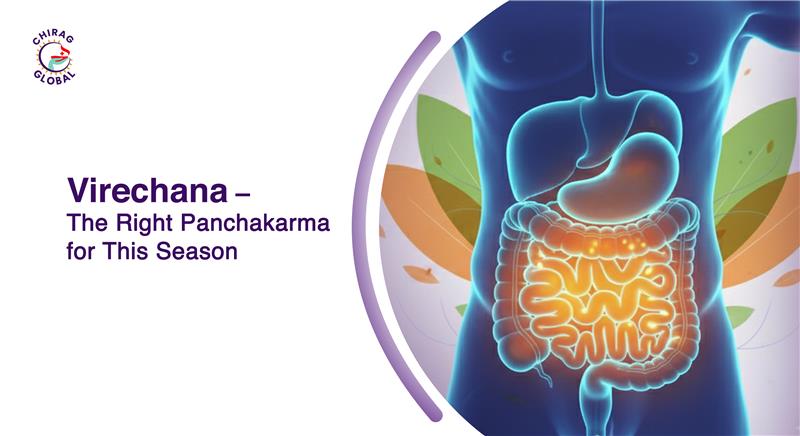Experience the ancient wisdom of Ayurvedic seasonal cleansing with Chiraayu — India’s trusted Ayurvedic Wing for authentic Panchakarma detox therapies.
Why Seasonal Detox Is Vital in Ayurveda
Ayurveda, the timeless science of life, teaches that human health is intimately connected with the cycles of nature. As the seasons change, our body undergoes subtle yet significant shifts in energy, metabolism, and dosha balance. This natural transition can accumulate Ama (toxins) and disturb doshic harmony, leading to sluggishness, digestive issues, allergies, and fatigue.
To prevent this imbalance, Ayurveda prescribes Ruthu Shodhana, a seasonal detoxification process that cleanses the body and restores internal balance. Among the five classical Panchakarma therapies, Virechana is considered the most suitable and effective for detoxification during Sharad Ruthu (approximately mid-September to mid-November), when Pitta dosha tends to accumulate and needs to be pacified.
At Chiraayu Ayurveda, we honour this ancient wisdom through personalised Panchakarma detox programs designed to align your health with nature’s rhythm, and this season, Virechana takes centre stage.
Understanding Ruthu Shodhana — The Concept of Seasonal Cleansing
In Ayurveda, Ruthu means “season” and Shodhana means “cleansing” or “purification.”
Ruthu Shodhana is not just a physical cleanse; it is a ritual of renewal, a way to reset the body, mind, and spirit with the natural flow of time.
According to Charaka Samhita (Sutra Sthana 6/14), each season influences the Tridoshas — Vata, Pitta, and Kapha. When these energies become aggravated or depleted due to dietary habits or environmental exposure, imbalances occur. Ruthu Shodhana helps to expel these excess doshas through specific Panchakarma therapies aligned to the season.
For example:
- During Vasanta (Spring) — Kapha accumulates and needs elimination through Vamana (emesis), which involves the therapeutic induction of controlled vomiting to expel excess Kapha from the body.
- During Grishma (Summer) — Pitta rises, calling for Virechana (purgation), a gentle cleansing therapy that removes accumulated heat and toxins through loose motions (loose stools).
- During Varsha (Monsoon) — Vata aggravates, requiring Basti (enema) therapy to restore balance and improve bodily functions.
Thus, Virechana becomes the ideal Panchakarma detox for this season, promoting Pitta balance and preventing seasonal ailments.
What Is Virechana in Ayurveda?
Virechana is one of the five main purification therapies in Panchakarma. The term derives from the Sanskrit root “Virech” meaning “to expel.”
It is a controlled purgation therapy that eliminates the accumulated Pitta dosha and Ama from the body through the lower pathways.
In simple terms, Virechana is a natural Ayurvedic cleansing therapy designed to:
- Purify the intestines and liver,
- Eliminate toxins from the digestive tract,
- Balance Pitta-related disorders such as skin issues, acidity, and inflammation,
- Restore lightness and clarity in both body and mind.
As mentioned in the Ashtanga Hridaya (Sutra Sthana 18/2):
“Virechana expels impurities from the small intestine and liver, pacifying aggravated Pitta and purifying the entire system.”
How Virechana Works — Step-by-Step Process
At Chiraayu Ayurveda, Virechana is performed under the guidance of experienced Vaidyas (Ayurvedic physicians). The process is gentle, systematic, and customised to your body constitution (Prakriti), current doshic imbalance (Vikriti), and seasonal factors.
Here’s a simplified step-by-step outline of the Virechana process:
1. Poorva Karma — Preparation Phase
This phase prepares the body for detox through:
- Deepana and pachana: Internal medications are given to prepare the body for the intake of large amounts of fat by digesting the undigested toxins and improving the digestive level.
- Snehana (Internal and External Oleation): Application and ingestion of medicated ghee or oils to loosen toxins and bring them into the digestive tract.
- Swedana (Sudation or Herbal Steam Therapy): Helps open body channels (Srotas) and mobilise doshas toward the gut.
2. Pradhana Karma — Main Cleansing Phase
- A carefully chosen herbal purgative (such as Trivrit lehya or Avipattikar churna) is administered early in the morning.
- The patient undergoes multiple bowel movements, releasing toxins and excess Pitta from the body.
- This phase is closely monitored by the physician to ensure comfort and balance.
3. Paschat Karma — Post-Cleansing Care
- Gradual reintroduction of food through Samsarjana Krama, starting with light gruels and soups (Manda, Peya, Vilepi).
- Rest, meditation, and herbal tonics are advised to rebuild digestive strength (Agni) and stabilise doshas.
Conclusion — Embracing Ayurveda’s Wisdom for Seasonal Health
Nature changes rhythm with every season, and Ayurveda teaches us to flow with it, not against it. Through Ruthu Shodhana, especially the Virechana Panchakarma detox, we can align our inner systems with the external environment, ensuring balance, vitality, and resilience.
At Chiraayu Ayurveda, our Virechana programs are rooted in the classical teachings of Charaka and Sushruta, tailored with compassionate care for modern lifestyles. This season, give your body the renewal it deserves, the Ayurvedic way.
Continue reading here to know more: Virechana





Comments